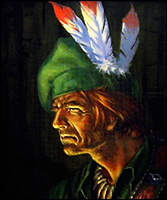
When you think of the word, “frontiersman”, Robert Rogers (1731 -1795) was the living embodiment of the word. The Indian’s gave him the name Wobi Mandanondo, “The White Devil” because of his cunning in commanding the famous Rogers’ Rangers that fought for the British during the French and Indian War. Rogers’ Rangers were the only non-Indian force capable of operating in the inhospitable mountainous terrain during the harsh winter. The US Army Rangers, to this day, use his “Rogers’ Rules of Ranging” in the U.S. Army’s Ranger handbook.
Rogers Slide, at the northern end of the lake, is so named after the legend which circulated after the Second Battle of the Snowshoes on March 13, 1758 were Rogers himself was originally reported by the French to have been killed, which in fact was not true. This report stemmed from the manner of Rogers’ escape during which he discarded some of his belongings, including his regimental coat, and supposedly slid down 400 feet to the frozen surface of Lake George and escaped over the ice. While there is no proof of this event, the rockface he supposedly went down has become known as ‘Rogers’ Slide or ‘Rogers Rock.’
The story of his life is quite fascinating, starting with him being a member of a counterfeiting gang, to being sent to America as punishment, ultimately being charged with treason but later being vindicated, all the way to being arrested by George Washington during the revolution to finally ending up in a debtor’s prison. We can only assume that somewhere along the way he walked in Huletts. A statue was dedicated to him, on Rogers Island in Fort Edward on Memorial Day 2005. It’s a nice stop on the way home on a Sunday afternoon.
For a fascinating read about a fascinating life, this book is great and for an interesting take by a local author, check this site out.
